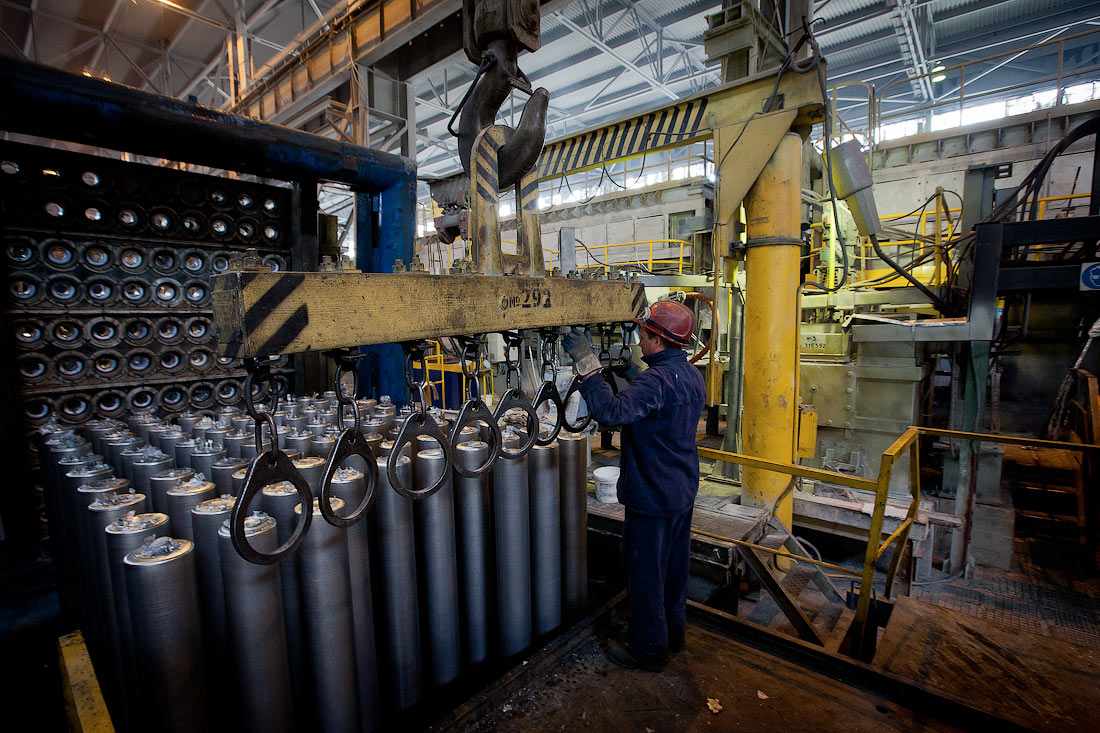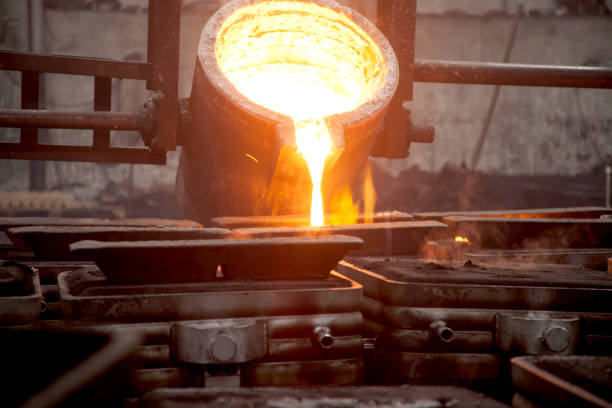The environmental benefits of Aluminum Foundry over plastic
Everything About Aluminum Foundry: Secret Uses and Its Impact on Item Growth
Aluminum foundries are important in contemporary production, especially in markets such as auto and aerospace. They use innovative methods to produce light-weight, durable components that improve efficiency. The flexibility of aluminum likewise lines up with sustainability initiatives, making it a preferred material. Nonetheless, the recurring innovations in casting methods and their effects for product advancement raising vital questions. What future innovations might reshape the landscape of aluminum foundries and their applications?
Overview of Aluminum Foundries
Aluminum foundries work as vital centers in the metalworking sector, concentrating on the casting of aluminum and its alloys. These facilities utilize numerous methods, including sand casting, pass away casting, and financial investment casting, to change raw aluminum into usable kinds. Each casting strategy supplies unique advantages, catering to different job demands ranging from small components to huge architectural components.
The foundries run through a precise procedure that begins with melting aluminum, adhered to by putting the liquified metal right into mold and mildews. After cooling, the castings go through finishing processes, which may entail machining and surface therapy to satisfy accurate specifications.
Quality assurance is vital, making sure that the final items fulfill market standards and client expectations. Furthermore, aluminum foundries often stress sustainability by recycling scrap aluminum, thereby lowering waste and saving sources. This commitment to efficient production and environmental duty settings aluminum foundries as essential contributors to the manufacturing landscape.

Key Applications of Aluminum Castings
Aluminum castings offer critical functions in different sectors, particularly in automobile and aerospace fields. In the vehicle market, they add to light-weight frameworks and efficient performance. Aerospace element production depends on aluminum castings for their toughness and corrosion resistance, important for high-performance applications.
Automotive Market Applications
In the automobile market, aluminum castings play a crucial function in improving car performance and effectiveness. These castings are extensively utilized for components such as engine blocks, transmission housings, and suspension components. Their light-weight nature adds to lowered car weight, which subsequently enhances gas economic situation and handling. In addition, aluminum's exceptional thermal conductivity enables effective heat dissipation, important for high-performance engines. The rust resistance of aluminum likewise prolongs the life expectancy of automobile components, lowering maintenance prices. In addition, innovations in casting modern technologies allow the production of intricate forms, enhancing the design and capability of components. Overall, aluminum castings are integral to modern-day automobile engineering, sustaining development and sustainability in vehicle style.
Aerospace Part Production
The aerospace industry significantly depends on aluminum castings for an array of important parts because of their advantageous residential or commercial properties. Light-weight yet strong, aluminum castings boost fuel performance and overall efficiency in airplane style. Elements such as engine installs, structural structures, and landing equipment are frequently created using aluminum casting methods, making it possible for producers to attain complex geometries while maintaining structural integrity. The high resistance to deterioration and thermal residential or commercial properties of aluminum additionally add to the long life and reliability of aerospace components. Furthermore, advancements in casting innovations, such as precision casting and 3D printing, have broadened the capacities of aluminum in this sector. Ultimately, aluminum castings play a necessary role in conference rigid safety requirements and performance demands in modern-day aerospace applications.
Benefits of Making Use Of Aluminum in Manufacturing
While various products are readily available for manufacturing, aluminum stands apart because of its special combination of homes that boost performance and efficiency. One substantial benefit of aluminum is its light-weight nature, which contributes to decreased energy consumption and improved fuel effectiveness in numerous applications. In addition, aluminum exhibits excellent corrosion resistance, extending the life expectancy of products and decreasing maintenance prices. Its high thermal and electrical conductivity makes it ideal for warmth exchangers and electrical components, while its pliability enables for versatile designs and intricate shapes.
Aluminum is recyclable, promoting sustainability in producing processes. This reusability not only preserves resources but additionally decreases the carbon footprint related to manufacturing. The flexibility of aluminum to different alloys further improves its energy in varied sectors, from auto to consumer electronics. Collectively, these features make aluminum an optimal selection for suppliers seeking to balance efficiency, cost-effectiveness, and ecological responsibility.
Developments in Casting Strategies
Recent improvements in casting techniques have actually substantially changed the aluminum shop industry. The assimilation of 3D printing modern technology has actually made it possible for extra complex styles, while improved alloy formulas boost performance and longevity. These advancements are driving performance and expanding the applications of aluminum in different fields.
3D Printing Assimilation

Boosted Alloy Formulations
Advancements in aluminum factory technology have actually caused the development of improved alloy formulas that enhance casting performance and material residential or commercial properties. These ingenious formulations usually incorporate components such as silicon, magnesium, and copper, which maximize toughness, ductility, and deterioration resistance. By fine-tuning the structures, makers can achieve details characteristics tailored to diverse applications, from vehicle to aerospace markets. In addition, these boosted alloys assist in far better fluidness throughout the casting procedure, decreasing flaws and boosting surface area finish. Consequently, the performance of production is significantly boosted while preserving strict high quality requirements. This development in alloy growth not just improves production yet additionally sustains the creation of lighter, more powerful elements, ultimately advancing product advancement and performance.
Effect on Aerospace and Automotive Industries
The noteworthy influence of aluminum foundries on the aerospace and automobile industries can not be overstated. Aluminum alloys, recognized for their light-weight redirected here and high toughness, have reinvented the design and manufacturing procedures in both sectors. In aerospace, the reduction in weight directly associates to sustain effectiveness, permitting longer trips and lower exhausts. Parts such as airplane structures, wings, and engine components take advantage of aluminum's excellent fatigue resistance and corrosion resistance.
In the auto industry, aluminum foundries add to the manufacturing of lighter automobiles, improving performance and gas economic situation while fulfilling strict environmental regulations. Using aluminum in engine blocks, body panels, and wheels has actually boosted significantly, driven by customer demand for more efficient cars. Furthermore, innovations in casting techniques have actually boosted the accuracy and capability of components, allowing producers to develop more incorporated and intricate styles, thus promoting advancements in both sectors.
Sustainability Practices in Aluminum Foundries
Aluminum foundries are significantly embracing sustainability methods to lower their ecological footprint while meeting the growing demands of the aerospace and vehicle industries. These practices consist of the execution of energy-efficient modern technologies, such as electrical melting heaters and advanced warmth healing systems, which considerably reduced power consumption (Aluminum Foundry). Additionally, several foundries are prioritizing using recycled aluminum, which needs less power and results in lowered greenhouse gas emissions contrasted to key aluminum production
Water preservation initiatives are also gaining grip, with foundries using closed-loop systems to lessen water usage and stop contamination. Additionally, waste administration techniques, consisting of recycling scrap and minimizing harmful waste, add to a much more lasting operation. By embracing these practices, aluminum foundries not just improve their competitiveness however also align with global sustainability objectives, eventually sustaining a circular economic situation and fostering advancement in eco pleasant manufacturing procedures.
Future Patterns in Aluminum Spreading Technology
As the need for light-weight and sturdy products continues to increase, technologies in casting technology are poised to improve the aluminum sector. Advanced methods such as 3D printing and automated casting procedures are gaining traction, permitting extra complex geometries and lowered material waste. The integration of synthetic knowledge and artificial intelligence is likewise boosting quality assurance and procedure optimization, minimizing defects and improving effectiveness.
The advancement of new aluminum alloys is broadening the application variety of actors items, making them appropriate for sectors from automotive to aerospace. Enhanced recycling techniques are expected to further reduce environmental influences, lining up with global sustainability goals.
In addition, the use of smart sensors in casting processes is expected to allow real-time surveillance, ensuring higher accuracy and consistency. These trends signify a transformative era in aluminum casting innovation, allowing producers to meet evolving market needs while focusing on sustainability and development.
Regularly Asked Inquiries
How Is Aluminum Recycled After Usage in Products?
Aluminum recycling entails accumulating, arranging, and melting used aluminum items (Aluminum Foundry). The molten steel is then cast into new types, minimizing power intake and preserving natural deposits, making it an effective and lasting process for aluminum healing
What Precaution Are Implemented in Aluminum Foundries?
Precaution in aluminum foundries include appropriate air flow systems, personal protective devices, routine safety and security training, equipment upkeep methods, and emergency action strategies, all intended at minimizing dangers linked with high temperatures and harmful products throughout production.
How Do Aluminum Foundries Make Certain Quality Assurance?
Aluminum foundries execute strenuous top quality control processes, consisting of product evaluations, temperature level surveillance, and dimensional checks. These measures guarantee item uniformity, minimize problems, and abide by sector criteria, eventually boosting consumer satisfaction and operational performance.
What Prevail Obstacles Dealt With by Aluminum Foundries?
Aluminum foundries generally face obstacles such as preserving consistent top quality, handling manufacturing costs, ensuring prompt shipment, dealing with click resources devices maintenance, and adjusting to evolving sector guidelines. These elements can substantially influence overall functional effectiveness and productivity.
How Does Aluminum Casting Affect Product Weight?
Aluminum casting considerably reduces product weight due to aluminum's low thickness contrasted to other metals - Aluminum Foundry. This lightweight particular boosts design adaptability, improves fuel efficiency in transport applications, and supplies advantages in numerous sectors requiring weight-sensitive parts